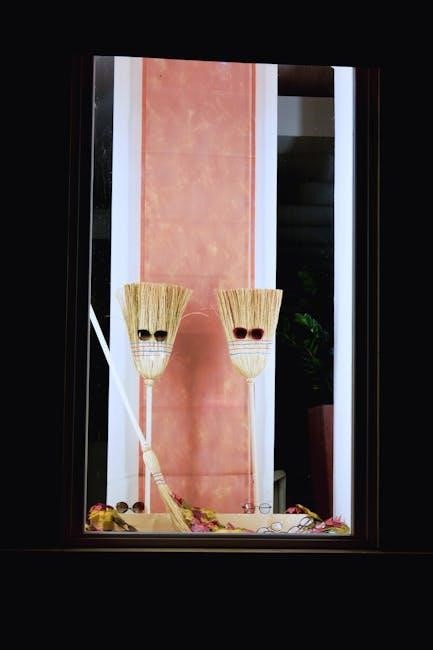Mia and Sebastian’s Theme, composed by Justin Hurwitz for La La Land, is a hauntingly beautiful melody capturing the film’s emotional depth. It has become a modern classic, resonating with audiences worldwide for its timeless elegance and heartfelt resonance.
Overview of the Theme
Mia and Sebastian’s Theme, composed by Justin Hurwitz for the film La La Land, is a captivating melody that embodies the emotional core of the movie. The theme is central to the story, symbolizing the relationship between Mia and Sebastian and their shared passion for art. Its hauntingly beautiful piano-driven arrangement has made it a standout piece in modern film music. The theme is widely available in sheet music formats, including PDFs for piano solo, duets, and instrumental arrangements. Many versions offer transpositions to accommodate different skill levels and instruments. Fans and pianists alike appreciate its accessibility, with both free and paid options available online. The theme’s timeless elegance and emotional depth continue to inspire musicians and audiences worldwide, making it a beloved piece in contemporary music.
Historical Context and Inspiration
Mia and Sebastian’s Theme, from the film La La Land, draws inspiration from the rich tradition of Hollywood musicals and the romanticism of classic jazz. Composer Justin Hurwitz crafted the piece to evoke a sense of nostalgia, blending modern and timeless elements. The theme reflects the film’s homage to the golden age of cinema and its exploration of artistic ambition. Hurwitz’s work was influenced by iconic composers like Claude Debussy and Max Steiner, while maintaining a contemporary feel. The melody’s emotional depth and simplicity were designed to resonate with audiences, capturing the essence of Mia and Sebastian’s relationship. This piece stands as a testament to the enduring power of film music to evoke emotion and tell stories, making it a cornerstone of modern cinematic composition.

Sheet Music Availability
Mia and Sebastian’s Theme sheet music is widely available online, offered in various formats and arrangements for pianists, ensuring accessibility for both beginners and advanced musicians.

Free Download Options
Several websites offer free PDF downloads of Mia and Sebastian’s Theme sheet music, allowing pianists to access this beloved piece without cost. Platforms like PianoKafe and ThePianoKeys provide high-quality transcriptions, often in multiple keys or transpositions. Additionally, communities such as MuseScore and SheetMusicFree host user-contributed arrangements, including piano solos, duets, and instrumental versions. These resources cater to both beginners and advanced musicians, ensuring accessibility for all skill levels. Many downloads include MIDI files and chord charts, enhancing the learning experience. Fans of the film can also find interpretations by various arrangers, such as Leiki Ueda and David Kaylor, offering fresh perspectives on the theme. With a wide range of options available, pianists can easily find a version that suits their needs, making this iconic melody more accessible than ever.
Paid Sheet Music Platforms
For those seeking high-quality sheet music, paid platforms like Musicnotes and SheetMusicPlus offer official arrangements of Mia and Sebastian’s Theme. These platforms provide professionally transcribed scores, ensuring accuracy and clarity. Available in various formats, including piano solo and instrumental versions, the sheet music is tailored to meet the needs of musicians at all skill levels. Many arrangements include additional features such as chord charts, MIDI files, and transpositions, enhancing the learning and performance experience. By purchasing from these reputable sites, users support the creators and gain access to reliable, premium resources. Whether for personal enjoyment or professional use, paid platforms deliver the best quality and versatility for enthusiasts of this timeless melody from La La Land.
Version Variations

Mia and Sebastian’s Theme is available in numerous arrangements, catering to diverse musical preferences and skill levels. Piano solo versions remain the most popular, offering a stripped-down yet powerful rendition of the melody. Instrumental versions feature ensembles, blending piano with strings, winds, or jazz elements to create rich textures. Vocal arrangements, though less common, add a lyrical dimension to the piece. Transpositions allow the theme to be adapted for various instruments, from violin to guitar, ensuring its universal appeal. Additionally, MIDI files and chord charts are available, aiding musicians in learning and performing the piece. These variations not only showcase the theme’s versatility but also provide a platform for creative reinterpretations, ensuring its enduring presence across different musical genres and formats.
PDF Sources and Formats
Mia and Sebastian’s Theme is widely available in PDF format, offering convenience for musicians and enthusiasts. Free downloads can be found on platforms like SheetMusicFree.com and PianoKafe, while paid versions on sites like Musicnotes and SheetMusicPlus provide high-quality arrangements. The PDFs are typically in standard sheet music format, with clear musical notation and chord charts. Some versions include MIDI files for digital playback and learning. The theme is offered in various formats, such as Piano Solo, Piano Duet, and instrumental arrangements for violin, guitar, and flute. These PDFs cater to different skill levels, from beginner to advanced, ensuring accessibility for all musicians. Additionally, transposed versions allow adaptation to various keys and instruments, making the piece versatile for diverse performances and interpretations. This accessibility has contributed to the theme’s widespread popularity and enduring appeal.
Tips for Pianists
Mastering Mia and Sebastian’s Theme requires attention to dynamics and emotional expression. Start by practicing the melody at a slower tempo to ensure accuracy. Pay special attention to arpeggios and chord progressions, as they convey the theme’s emotional depth. Use pedaling techniques to maintain a flowing sound, especially in the piano solo arrangement. Focus on phrasing to highlight the melancholic and hopeful contrasts. For beginners, breaking the piece into smaller sections can aid in learning. Intermediate players can explore rubato to add personal interpretation. Advanced pianists may experiment with nuanced articulations and tempo variations. Listening to the original soundtrack and studying sheet music annotations can provide valuable insights. Regular practice and a focus on expression will help pianists capture the essence of this iconic piece.

Musical Arrangements
Mia and Sebastian’s Theme is available in various arrangements, including piano solo, instrumental versions, and transpositions for different instruments, making it accessible to musicians of all skill levels and preferences.
Piano Solo Arrangements
Piano solo arrangements of Mia and Sebastian’s Theme offer a captivating rendition of the melody, allowing pianists to delve into its emotional depth. These arrangements are available in various formats, including PDF, and often feature intricate details that capture the essence of the original composition. Many versions are transposed into different keys to suit pianists of all skill levels, from beginners to advanced players. The sheet music typically includes chord progressions, dynamics, and tempo markings, ensuring an authentic performance. Additionally, some arrangements incorporate embellishments and grace notes, enhancing the piece’s expressive qualities. With the rise of digital platforms, these piano solo arrangements are easily accessible for download, making it convenient for enthusiasts to practice and perform this beloved theme from La La Land.
Instrumental Versions
Mia and Sebastian’s Theme is widely available in various instrumental versions, catering to diverse musical preferences and skill levels. These arrangements include renditions for violin, guitar, flute, and even full orchestral ensembles, allowing musicians to explore the melody across different timbres. The violin version, for instance, adds a lyrical quality, while the guitar arrangement offers a more intimate feel. Additionally, some versions feature instrumental duets or trios, blending piano with strings or woodwinds for a richer harmonic texture. Platforms like Musicnotes and Sheet Music Plus provide access to these instrumental arrangements in PDF format, ensuring ease of download and performance. These versions not only highlight the theme’s versatility but also invite musicians to interpret the piece in their unique style, further enriching its emotional resonance and cultural impact.
Transpositions for Different Instruments
The sheet music for Mia and Sebastian’s Theme is available in transpositions tailored to various instruments, ensuring accessibility for musicians of all kinds. These transpositions allow the melody to be adapted for instruments such as the violin, flute, and guitar, preserving its emotional depth while fitting the unique characteristics of each instrument. Many platforms offer transposed versions in PDF format, enabling seamless downloads for performance. For example, pianists can explore the theme in its original key of A Major, while violinists can access arrangements in keys that suit their range. Additionally, some versions include transpositions for ensembles, blending piano with strings or woodwinds to create a fuller sound. These transpositions not only expand the piece’s versatility but also encourage collaboration among musicians, fostering a deeper connection to the music.
Covers and Interpretations
Mia and Sebastian’s Theme has inspired countless covers and interpretations, showcasing its universal appeal. Musicians worldwide have reimagined the piece, infusing it with their unique styles, from soulful vocal renditions to intricate instrumental arrangements. Pianists, violinists, and even jazz ensembles have offered their takes, each capturing the theme’s emotional essence. These interpretations often blend contemporary and classical elements, reflecting the timeless quality of Justin Hurwitz’s composition. Additionally, many covers are available as downloadable PDFs, allowing fans to explore and perform these creative adaptations. The theme’s versatility has made it a favorite among music enthusiasts, with interpretations ranging from minimalist solos to grand orchestral arrangements. This diversity highlights the enduring charm of Mia and Sebastian’s Theme, ensuring its place in modern musical culture. Its ability to evoke emotion across genres continues to inspire new artistic expressions, solidifying its legacy as a modern classic.

Composer Background
Justin Hurwitz, born in 1985, is an American composer known for his work on films like La La Land, Whiplash, and First Man. His compositions blend emotional depth with modern elegance, earning critical acclaim and numerous awards.
Justin Hurwitz’s Musical Journey
Justin Hurwitz’s musical journey began with a passion for jazz and classical music, leading him to study composition at the University of Michigan. His breakthrough came with Whiplash, where his dynamic scores garnered widespread acclaim. Collaborating with director Damien Chazelle, Hurwitz’s compositions for La La Land and First Man solidified his reputation as a master of blending emotional depth with cinematic grandeur. His work on Mia and Sebastian’s Theme showcases his ability to craft melodies that resonate deeply with audiences, earning him numerous awards and nominations. Hurwitz’s journey continues to inspire musicians and film enthusiasts alike, proving his enduring impact on contemporary film music.
Composition Process of the Theme
The composition of Mia and Sebastian’s Theme was a collaborative and iterative process between Justin Hurwitz and director Damien Chazelle. Hurwitz initially crafted a simple yet evocative melody, which Chazelle refined to align with the film’s emotional narrative. The theme underwent multiple revisions, with Hurwitz experimenting with orchestral textures and harmonic structures to evoke the timeless elegance of classic Hollywood. The piano was central to the composition, serving as the emotional backbone of the piece. Hurwitz incorporated subtle tempo changes and dynamic shifts to mirror the characters’ evolving relationship. The final arrangement blended intimate solos with lush orchestral elements, creating a piece that not only complemented the film but also stood as a standalone work. This meticulous process ensured the theme became an iconic part of La La Land’s legacy.
Other Notable Works by Justin Hurwitz
Justin Hurwitz, renowned for composing Mia and Sebastian’s Theme, has a diverse portfolio of notable works. His score for Whiplash (2014) showcased his ability to blend jazz with intense dramatic tension. Hurwitz also composed the music for First Man (2018), a biographical drama about Neil Armstrong, earning widespread acclaim for its emotional depth and orchestral grandeur; His work on La La Land (2016) solidified his reputation as a master of modern film scores, blending nostalgia with contemporary flair. Hurwitz’s compositions often explore themes of ambition, love, and human achievement, resonating deeply with audiences. His ability to craft memorable melodies and evoke profound emotion has made him a standout composer in Hollywood.
Inspiration Behind the Composition
The inspiration for Mia and Sebastian’s Theme stemmed from the emotional core of La La Land, capturing the essence of Mia and Sebastian’s relationship. Justin Hurwitz aimed to create a melody that reflected their shared dreams, love, and aspirations. The theme blends nostalgic jazz influences with classical orchestration, evoking a timeless feel. Hurwitz drew inspiration from iconic Hollywood musicals, while infusing modern sensibilities to resonate with contemporary audiences. The composition symbolizes the enduring magic of their story, transcending time and circumstance. Its hauntingly beautiful piano solo has become iconic, representing the bittersweet journey of two artists chasing their passions. The theme’s emotional depth and memorable melody have made it a standout piece in modern film music, celebrated for its ability to evoke both joy and longing.

Role in La La Land
Mia and Sebastian’s Theme is central to La La Land, serving as a musical motif that underscores the emotional journey and relationship between the two protagonists, resonating deeply with the film’s narrative.

Context Within the Film
Mia and Sebastian’s Theme is intricately woven into the narrative of La La Land, serving as a musical anchor for the evolving relationship between Mia and Sebastian. The melody first appears during their initial encounter at the Griffith Observatory, symbolizing the spark of their connection. As the story progresses, the theme evolves, reflecting the emotional highs and lows of their journey. It is prominently featured in pivotal scenes, such as their romantic dance under the stars and their bittersweet reunion years later. The theme becomes a metaphor for their shared aspirations and the fleeting nature of love. Composed by Justin Hurwitz, it underscores the film’s nostalgic and dreamlike quality, ensuring its place as a defining element of the movie’s emotional core.
Success and Recognition of the Film
La La Land achieved critical acclaim and commercial success, earning numerous prestigious awards, including a record-breaking seven Golden Globe Awards. The film’s soundtrack, featuring Mia and Sebastian’s Theme, received widespread praise for its emotional depth and nostalgic charm. The movie garnered fourteen Academy Award nominations, winning six, including Best Director for Damien Chazelle. The film’s success can be attributed to its captivating storyline, vibrant visuals, and memorable music, with Mia and Sebastian’s Theme standing out as a highlight. Its impact extended beyond the screen, sparking a renewed interest in musical cinema and inspiring countless covers and arrangements of its iconic theme. The film’s success solidified its place in modern cinematic history, making it a beloved classic among audiences and critics alike.
Other Themes from the Soundtrack

Beyond Mia and Sebastian’s Theme, the La La Land soundtrack features a variety of memorable compositions by Justin Hurwitz. One standout piece is “Another Day of Sun,” an energetic ensemble opener that sets the film’s vibrant tone. “City of Stars,” performed by Ryan Gosling and Emma Stone, became a fan favorite, blending romantic lyrics with a melancholic melody. “Audition (The Fools Who Dream)” showcases Emma Stone’s powerful vocals, while “Someone in the Crowd” offers an upbeat, hopeful vibe. These themes, along with “Jazz Hermosa” and “Stupido,” contribute to the soundtrack’s diverse and emotionally rich landscape, each piece complementing the film’s narrative and enhancing its visual splendor. Together, they create a harmonious blend that resonates with listeners long after the credits roll.

Cultural Impact
Mia and Sebastian’s Theme has inspired countless pianists and music enthusiasts, becoming a staple in modern piano education and sparking widespread admiration for its emotional depth and elegance.
Public Reception and Popularity
Mia and Sebastian’s Theme has captivated audiences globally, becoming a modern classic. Its emotional depth and timeless elegance have resonated deeply, making it a favorite among pianists and music enthusiasts. The theme’s popularity is evident in its widespread availability across various platforms, with both free and paid sheet music options. Its accessibility has allowed it to reach a broad audience, from professional musicians to hobbyists. The piece is often featured in piano tutorials, covers, and educational materials, further amplifying its reach. Additionally, its inclusion in merchandise and memorabilia highlights its cultural impact beyond the film. The theme’s ability to inspire and connect with people has solidified its place as one of the most beloved contemporary compositions, continuing to influence and delight listeners worldwide.
Educational Use in Music Classes
Mia and Sebastian’s Theme has become a valuable resource in music education, offering students insight into modern film composition and emotional expression. Its availability in various formats, including PDF sheet music, makes it accessible for classroom use. Educators often use the piece to teach chord progressions, phrasing, and interpretive techniques. The theme’s emotional depth allows students to explore dynamics and nuanced playing, fostering both technical and artistic growth. Many music schools incorporate this piece into their curriculum, particularly for piano students, as it provides a contemporary yet timeless example of musical storytelling. Its popularity ensures that students are engaged and motivated, bridging the gap between classical training and modern film music. Additionally, the theme’s variations and arrangements offer versatile learning opportunities for students of different skill levels.
Memorabilia and Merchandise
The popularity of Mia and Sebastian’s Theme has led to a variety of memorabilia and merchandise, allowing fans to celebrate their love for the music and the film. Sheet music editions, including PDF downloads, are widely available, offering pianists and musicians the chance to play the theme themselves. Posters, CDs, and vinyl records featuring the soundtrack are also popular among collectors. Additionally, apparel and accessories, such as T-shirts and tote bags, often showcase the iconic imagery from La La Land. For enthusiasts, there are even limited-edition items like signed sheet music and exclusive piano arrangements. These items not only honor the theme’s beauty but also serve as lasting mementos for fans of the film and its unforgettable soundtrack.


